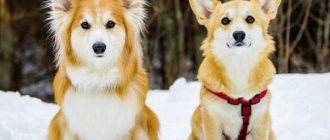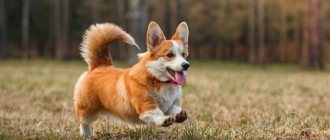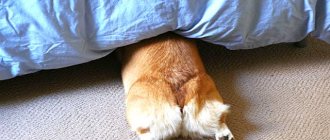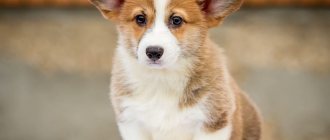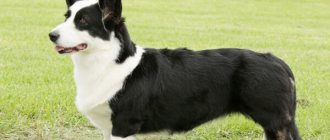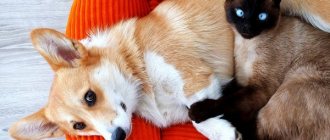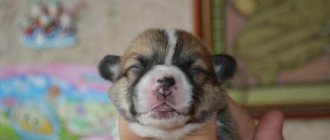Unusual Fluffy Welsh Corgi dogs are the same representatives of the Corgi breed, differing only in the type of coat. Fluffy's fur is long, fluffy and very thick. And although this sign is grounds for culling, the breed has the right to exist as a family pet, friend and companion. The smallest of the shepherd dogs has fearlessness, loyalty, and intelligence. These dogs love to learn, have a non-conflict disposition, and respond well to training.
History of the Cardigan Welsh Corgi breed
Cardigan Welsh Corgi
The history of the Welsh Corgi breed consists of several hypotheses, a lot of speculation, a couple of legends and almost not a single reliable fact. For example, some experts believe that the ancestors of today's dogs appeared in the British Isles along with Scandinavian settlers in the Bronze Age. Others attribute animal breeding to the Celts, who inhabited England around 1500 BC. e.
Not everything is clear about the genetic base either, so some people call the Welsh Corgis the ancestors of Icelandic dogs, while others attribute them to the descendants of the Swedish Vallhunds. However, the Welsh would not be Welsh if they had not given this phenomenon their own, purely mystical justification. In the homeland of the breed, they still believe that Welsh Corgis were given to the people of Wales by fairy-tale creatures (fairies), who used the animals as horses, riding them and transporting their own belongings with their help.
As for the Cardigan Welsh Corgi specifically, this branch was born through the efforts of enthusiasts in the Welsh county of Cardiganshire (Ceredigion). It is generally accepted that in order to breed an unassuming herding dog, local farmers crossed the ancestors of Welsh Corgis with dachshund dogs, which greatly affected the appearance of the animals. In particular, the body of shepherd dogs has become longer, and their legs have become significantly shorter.
The appearance of the Pembroke Welsh Corgi breed in the 13th century sharply reduced the popularity of Cardigans, since its representatives not only had the same short legs, but also had a more pleasant appearance. In particular, at the end of the 19th century, it was mainly natives of Pembrokeshire who “lit up” at breeding shows, which extremely irritated fans of Ceredigion Sheepdogs. Further - more: the confrontation between Cardigan and Pembroke breeders escalated into fights for exhibition places, so that in 1934 the KC (English Kennel Club) had to divide the animals into two independent breeds. In the same year, it was decided to dock the Pembroke’s tails, which became an additional delimiting factor between both families of Welsh Corgis.
However, despite the long-awaited independence and the opportunity to be exhibited separately at exhibitions, the Cardigan Welsh Corgi has long remained an underrated breed, hiding in the shadow of its more spectacular and successful relative. And if these funny short-legged creatures penetrated into other European countries several decades after the official announcement, in Russia they started talking about them only in the early 2000s.
Appearance of the Cardigan Welsh Corgi and its differences from the Pembroke
Pembroke Welsh Corgi
Cardigan Welsh Corgis are agile, long-bodied “gentlemen” with a soft topline and miniature, strong paws. Outwardly, these squat, handsome dogs are noticeably larger and more bony than the Pembroke Welsh Corgi. As an example: the average Pembroke weighs 10-12 kg, while the body weight of natives of Ceredigion can reach 14-17 kg. In general, there are much more differences between these two breeds than it seems at first glance. For example, dachshund genes predominate in cardies, which is why they have slightly curved legs, a massive chest and a smoother silhouette.
Cardigan Welsh Corgis are hard-working dogs, bred not for exhibitions, but for the drudgery of everyday work. It is not surprising that Pembrokes, which were born a little later and were the “product” of crossing a Spitz with a Welsh Corgi, are inferior to them in performance characteristics and endurance, but at the same time benefit in terms of external charm.
Fun fact: Until recently, the Cardigan could be identified by his bushy fox tail, which Pembrokes were traditionally shortened. However, after European breeders abandoned docking, it became more difficult to distinguish between animals. However, if you look closely, you will notice that the Pembrokeshire shepherds have a shorter tail (many years of crossing short-tailed individuals with tailless animals has made itself felt) and less luxurious.
Head
Cardigan Welsh Corgi puppies
The Cardigan Welsh Corgi has a very proportional head with a moderately elongated muzzle and a wide skull that narrows towards the eyes.
Teeth and jaws
The Cardigan Welsh Corgi's jaws are strong, strong, with a scissor or horizontal bite (the first option is preferable).
Nose
The lobe is black, not too large, but not miniature either.
Eyes
The shepherd's eyes are wide-set, with well-defined corners, and not round. The iris color is dark. For individuals with merle-colored fur, blue or bluish-spotted eye color is acceptable.
Ears
The Cardigan Welsh Corgi has large, erect ears with rounded tips, which are tilted forward in an alert dog, and slightly spread out to the sides in a resting dog.
Neck
Decent length, muscular, flowing into sculpted shoulders.
Face of a Cardigan Welsh Corgi
Frame
The body of the cardi should be long, with a well-defined loin line, without any bulge or sagging.
Limbs
Running cardigans
Despite the fact that the legs of representatives of this breed give the impression of being like toys, they have sufficient strength and provide a good push when running. The paws of the Cardigan Welsh Corgi are large, round, with plump pads. The front paws are slightly turned outward, which is especially noticeable when viewing the dog from the front.
Tail
The correct tail for a Cardigan Welsh Corgi is low set and carried down. In an excited dog, the tail can be slightly raised (the optimal option is to the level of the croup or slightly higher), but it should not curl into a donut and be thrown over the back.
Wool
Cardigan colors
The smooth, close-fitting “coats” of Cardigan Welsh Corgis are formed by moderately coarse hair of medium length and a thick layer of undercoat. The dog's coat should be smooth, but not silky, and certainly not stiff, like wire. A shepherd whose coat is too lush and soft is considered defective and is called fluffy.
Color
Breed standards for the coat color of Cardigans are less demanding than for the color of Pembrokes. Simply put, this breed of Welsh Corgi is eligible for any color type, including brindle and blue merle. The presence of white marks on the body is also not punishable by exhibition specialists. The main thing is that they do not dominate the main shade.
Disqualifying faults
- Drooping or drooping ears.
- White spots on the body, predominant over the main color.
- Completely blue or unevenly colored iris (does not apply to merle-colored individuals).
- Lobe of any color except black.
Appearance Features
Welsh Corgis are dogs whose appearance will not leave any person indifferent.
It is enough to look at a photo of a fluffy to immediately fall in love with this breed. The fox face gives the impression that the dog is always smiling. Short legs give the dog a funny look. Wool colors vary. There are individuals of bright golden and red colors. Often solidly colored dogs have white spots on the chest, paws and face. Dogs with a tricolor color look interesting: the main color is red, with spots of white and black.
Photo of Cardigan Welsh Corgi
Temperament of the Cardigan Welsh Corgi
Calmness bordering on slight phlegmaticity, good nature, and an excellent sense of humor - these are the three main qualities that define the character of the Cardigan Welsh Corgi. These cute short-legged dogs easily get along with anyone, and they are almost unfamiliar with such a feeling as jealousy. The only thing, unlike the same Pembrokes, Cardies do not really trust strangers and sometimes are not averse to barking at them. At the same time, in ordinary life, shepherd dogs, if they are properly raised, rarely make noise and only for good reasons.
Cardigan Team
Compared to the impulsive Pembrokes, the Cardigan Welsh Corgis are all restraint. They are quite energetic, but not hyperactive, sociable, but not intrusive, flexible, but not to the detriment of self-esteem. A dog’s best friends are the members of the family in which it lives, so the Cardigan Welsh Corgi is always happy to play around with the kids, lie next to its owner on the couch watching a TV series, or run around the park with him. In general, Cardies are very dependent on their owner, but this feature should not be associated with a lack of intellectual abilities. In fact, Cardigan Welsh Corgis are intelligent and insightful creatures; simply by working side by side with humans for centuries, they have practically lost the desire for independence. But these handsome people are not characterized by ambition, and they will never try to put themselves above the owner.
Despite the fact that today's Cardigan Welsh Corgis have practically said goodbye to herding activities, the instincts of their ancestors will still remind of themselves. In particular, modern cardi now guard not cows and sheep, but family members. This is especially evident in relationships with children. A baby who deviates from the desired trajectory and goes beyond the boundaries existing in the dog’s imagination will be slightly bitten on the legs. From the outside it looks funny, but it is better not to forget that while you are laughing and filming the “great confrontation” on video, the Cardigan Welsh Corgi perceives this as encouragement and will try and bite even more next time.
Nurseries
It is not recommended to buy a puppy secondhand or through advertisements from people with an unverified reputation. To purchase a puppy, it is better to contact professional nurseries. A decent breeder will tell you straight out that Fluffy is not a dog for exhibition, but a pet for the soul. If the seller starts talking about how the long-haired corgi is the newest type of breed, it is better to run away from there as quickly as possible. Most likely, the owner of the puppies is trying to mislead potential buyers.
In any Welsh Corgi nursery you can find fluffy puppies, since the risk of such non-standard babies is always high.
Breed:
- Nursery “Talisman Vasilisa”, Rostov region, Taganrog, www.lisatalisman.com
- Nursery “Zelveger” St. Petersburg, zelveger.ucoz.ru
Education and training
Cardigan Welsh Corgi training
In studies, Cardigan Welsh Corgis show themselves on the most positive side. The main thing is not to overdo it with seriousness and monotony. Due to their moderately lively temperament, cardies are happy to learn what is presented to them in a relaxed, entertaining form and quickly lose interest in commands and actions that imply stupid execution of the master's demands. Do not forget that the Cardigan Welsh Corgi is a highly specialized herding shepherd dog, which is not at all intended for service and security activities.
Start raising and socializing your puppy from the first minutes of his appearance in your home, and not at 6 months of age, as would-be experts on Internet forums advise you to do. The training of a 2-month-old baby is built approximately in the following sequence:
- familiarization with the home toilet (tray, diaper) and the ability to use it;
- leash and collar training;
- instilling obedience and setting boundaries of what is permitted.
At 3 months, a puppy can and should begin to be introduced to the outside world so that he does not get the impression that he is the only four-legged creature on the planet. To do this, walk more often in places where other animals (cats, dogs) run, and also arrange for your pet to meet people. At the same time, clearly explain to your baby that now the toilet for him is not only a tray and a diaper, but also the nearest bushes.
At 4-5 months, the Cardigan Welsh Corgi is smart enough to learn a minimum set of commands: “Near!”, “Sit!”, “Lie down!”. In addition, a 4-month-old puppy must understand that barking without a reason is the height of bad manners, and picking up foreign objects from the ground, even if they smell temptingly, is an activity unworthy of a real Welsh Shepherd.
Cardigan Welsh Corgi training
Important: teaching a Cardigan circus and acrobatic acts is not prohibited, unless it is jumping. Climbing onto horizontal surfaces and diving down from them is strictly contraindicated for representatives of this breed (they have paws, if you remember).
In the process of training six-month-old individuals, take into account the characteristics of adolescence. During this period, the Cardigan Welsh Corgi may deliberately disobey you and pretend to be incomprehensible. This breed is not prone to dominance, but the 6-month-old puppy will definitely try to bargain for some concessions. In addition, he may begin to spoil his shoes again, although three months ago he demonstrated complete indifference to such things.
How to identify a fluffy corgi puppy in a litter
It is impossible to recognize in a newborn puppy whether it will be a classic Corgi, or whether it will show signs of a long-haired representative of the breed. Even experienced breeders will not say with certainty whether a newborn corgi is a carrier of the fluffy gene.
The first signs are visible by the age of one month. The puppy's fur becomes fluffy, especially behind the ears and on the paws. By the age of two months it appears throughout the entire body. Such puppies look bulkier and larger than their brothers.
Maintenance and care
Like any shepherd, the Cardigan Welsh Corgi will certainly prefer a country house with a lawn to the most comfortable apartment. On the other hand, if you place a representative of this breed in a modest two-room apartment, he will not be offended by you, provided that you are not too lazy to go with him to the park or pick mushrooms in the nearest grove a couple of times a day.
When arranging a corner for a dog in a house or apartment, take into account the anatomical features of the breed. For example, a mattress-bed for a Welsh Corgi Cardigan should be strictly orthopedic, and a food bowl should be equipped with an adjustable stand so that the animal does not have to bend over too much.
Wash, wash my cardigan...
Hygiene
The smooth, hard coat of the Cardigan Welsh Corgi has dirt- and water-repellent functions, so it is better not to overuse this breed for full baths. It is recommended to arrange bath days no more often than once every three months (unless you have a show dog), and select shampoo for washing specifically for coarse hair.
Cardigan Welsh Corgis shed heavily twice a year. The first adult “hair fall” of a teenage puppy is especially impressive in its scale, often plunging the inexperienced owner into a state of shock. Don’t be afraid of this: with age, everything will settle down, and the Cardigan will shed no more and no less than the average shepherd dog. When it comes to daily hair care for your pet, an arsenal of combs will help you. A massage brush, a slicker rake, a comb with long teeth - you will have to spend money on these items simply because representatives of this breed will have to be combed every day. In addition, once a week, Cardi is also supposed to thoroughly work out the undercoat.
Ears are cleaned as needed with good old veterinary lotion and cotton swabs. But the Cardigan Welsh Corgi's claws will have to be trimmed more often (optimally - 2 times a month), since they grow quickly and often peel off. You should not neglect such an unpleasant procedure for both the owner and the dog as brushing your teeth. But it is better to carry it out as carefully as possible, since shepherd dogs’ teeth are very sensitive.
Walking and physical activity
Cardigan Welsh Corgi puppy on its first walk with its owner
The Cardigan Welsh Corgi is an energetic and active dog, but even its internal “battery” has its limit, so do not exhaust your pet with daily training. The optimal load option: walks at a lively, relaxed pace twice a day and three times a week agility classes, freestyle or just active games in the fresh air.
In the summer, you will have to look for a more shady place for walking, since due to the coat being too thick and dense, the Cardi can overheat in the sun. During the off-season, another problem arises - dirt that accumulates on the dog’s belly during walks (thanks to short legs). So if you don’t want to drag your pet to the bathroom after every trip outside, sew a raincoat for him in individual sizes - in pet stores the range of clothes for representatives of this breed is extremely poor.
When choosing four-legged playground friends for your Cardigan Welsh Corgi, make sure that they are medium-sized dogs. The fact is that cardigans are very bold by nature, and in the event of a conflict, the size of the enemy does not hold them back at all. Accordingly, if your ward is walking in, you are taking a big risk, since for a wolfhound such a short-legged animal is an annoying misunderstanding that can easily be removed from the path with one click of the jaws.
Feeding
Cardigan Welsh Corgis happily eat dry food, so if the owner has neither the time nor the desire to prepare a balanced diet for his pet, this option can be a good help. However, in some cases, the dog’s body may react to store-bought “drying” with allergies, changes in coat color (white hair takes on a pink tint) and intestinal problems.
With natural food things are simpler. Feed your Cardigan with lean frozen meat at the rate of 20 g of product per kilogram of the dog’s body weight, as well as liquid cereal porridges cooked in meat broth, and your ward will be healthy and happy. Just don’t overdo it, because Cardigan Welsh Corgis are gluttons who love to fill their stomachs too much and ask for more.
Oh thank you, it’s so nice!
Products that should be included in the Cardigan Welsh Corgi's diet:
- low-fat kefir, fermented baked milk, cottage cheese;
- vegetables (carrots, zucchini);
- apples;
- vegetable oil (as an additive, but not more than 1 tbsp per day);
- rice and buckwheat cereals.
1-2 times a week, the cardigan menu can be varied with offal, boiled chicken, fish fillet, egg and bread crumbs.
Prohibited:
- tomatoes, eggplants, grapes;
- mushrooms;
- bakery;
- nuts;
- sausages;
- sour cream and any fatty fermented milk products;
- millet and semolina cereals;
- bird bones;
- pasta;
- sweets.
Health and disease of the Cardigan Welsh Corgi
One of the weakest points of the breed is its teeth, which are often affected by periodontal disease. The metabolism of Welsh Corgi Cardigans is also not the most outstanding, so they often overeat and, as a result, quickly gain weight. As for genetic diseases, shepherds have few of them. Basically, animals inherit eye diseases from their parents (cataracts, lens luxation, glaucoma, keratitis), as well as hip dysplasia. Among other things, Cardigan Welsh Corgis are prone to food allergies and various types of eczema.
Fluffy corgi puppies cost
Compared to the price of a classic corgi, the price of fluffies is relatively low. In nurseries you can buy a baby at a price of 30 thousand rubles and more. The price for a standard corgi starts from 60 thousand rubles. You can find it cheaper through private advertisements, but such a risk may not be justified: under the guise of a purebred dog, the animal may turn out to be a simple mongrel.
How to choose a puppy
Cardigan Welsh Corgis are somewhat less popular and in demand than Pembrokes, which is why there are not many kennels breeding them. Take this fact into account and approach the choice of a pet carefully, armed with a standard of appearance, or even better, with the support of a specialist from the canine association.
Welsh corgi cardigan on stump
When choosing a Cardigan puppy, we recommend following several rules.
- Cardigan Welsh Corgi males are more trusting and efficient and are more willing to learn. Bitches are more cunning and flexible, so it’s easier for them to adapt to their owner’s mood.
- Cardies inherit the athletic abilities of their parents, so if you need a future agility champion, ask the breeder for working diplomas of his ancestors.
- Responsible breeders usually test the bitches and dogs they plan to breed for dysplasia. Play it safe and ask the seller for test results to protect yourself from buying a puppy with poor heredity.
- The optimal age for selling/buying a Welsh Corgi puppy is 8-12 weeks. Despite the fact that kennel clubs allow 45-day-old babies to be put up for sale, self-respecting kennels do not enjoy this privilege, preferring to keep the dog a little longer so that it receives the necessary vaccinations and gets stronger.
- It is best to take puppies from nurseries that practice country breeding. This means that babies will not be locked in cramped cages and will have enough space to play and develop.
Remember: experienced breeders and nurseries take the sale of their dogs very seriously and rarely offer auctions or puppies for reservation. The seller’s offer to “negotiate” the price is an alarming signal, because such concessions are usually made if the dog has serious defects that you have not yet had time to discern.
Cons of the breed
The long-haired Corgi has a funny appearance and fluffy fur. But it is precisely with it that there are disadvantages associated. It is not for nothing that the airiness of the coat is considered a disqualifying feature of the breed.
The soft wool of the Cardigan Fluffy and Pembroke breeds does not have hard guard hair and undercoat, and therefore cannot protect the dog from moisture and dirt. During even light rain, the dog gets wet within a few minutes. It takes a very long time to dry, your pet can become hypothermic and get sick. Also, wool does not protect against heat, but only creates a greenhouse effect. Therefore, the dog can get heatstroke.
Fluffy Welsh Corgis are dogs that have a number of difficulties in breeding. Corgi females rarely give birth on their own. Often only a caesarean section helps. The percentage of deaths of puppies in the first days after birth is high. Of the entire litter, only one baby can survive. There is also always a risk of the mother dying in childbirth.
One of the disadvantages of the breed is its high price.
